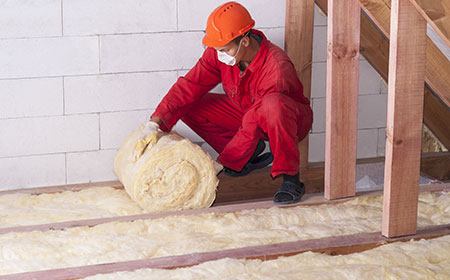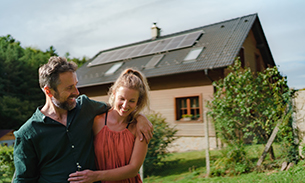On this page
Insulate your home

Why should you insulate your home?
You could be wasting a lot of heat and money if your home is poorly insulated. Well insulated homes need less energy to heat up and stay warmer for longer. So, spending some money up front could lead to lower energy bills and a home that’s more environmentally sustainable too.
It's also important to ensure your home is well insulated before you spend money on bigger, and often more costly, heating system changes like solar panels or heat pumps. If your home is still leaking heat, you won't get the full energy saving benefits of these improvements.
You could make a start on reducing heat loss with our five lower cost tips, then look at the different ways you could improve your home's insulation.
Five DIY heat saving ideas
There are some actions you could take to get started on reducing heat loss, which are relatively cheap and possible to do yourself in some cases:
- Wrap insulating material around heating pipes.
- Fit a special insulating jacket to your water tank.
- Place insulation on the back of loft hatches.
- Go for thicker curtains or blinds.
- Fit draught excluders to doors.
How to find an insulation installer
After you've taken some simple steps to reduce heat loss, it could be time to look at your roof, walls and floor. You don't need to do them all at once and may find that some of it's already well insulated.
It's important to use a reputable tradesperson, so that you understand what options are suited to your home and that any work is carried out to a high standard.
- Finding an insulation installer. Trustmark is the only Government endorsed quality scheme for work carried out in our around your home. Visit Trustmark website.
- Cavity wall insulation guarantee. The Cavity Insulation Guarantee Agency (CIGA) provides independent 25 year guarantees for cavity wall insulation fitted by registered installers in the UK. You can also find CIGA registered installers on their website. Visit CIGA website.
Roof insulation and loft insulation
A quarter of heat can be lost through an uninsulated roof, according to Energy Saving Trust (2022).
Heat rises, so a poorly insulated loft or roof space will let heat leak out of your home. Cold outside air can also cool your house if it gets into roof spaces.
As with the other forms of home insulation covered here, the type of insulation you need will depend on your property. Pitched or flat roofs and whether the space is used for anything are just some of the factors that will determine what you can do.
How much does loft or roof insulation cost? It will depend on what your home needs, including whether or not you just insulate the roof or lay insulation on the floor too. Again, speak with a professional who could also help you avoid any issues with damp or blocking necessary ventilation by mistake.
You could save money by fitting loft insulation yourself, if you know it's safe to work in the space and are sure there are no existing problems.
Cavity wall insulation
Walls account for as much as a third of all the heat lost in homes, according to Energy Saving Trust (2022). Cavity wall insulation is one way of reducing this heat loss.
Houses built from the 1920s/30s onwards usually consist of two brick walls with a space, or cavity, between them. If the cavity has no insulation, or is poorly insulated, then heat is more likely to escape through the wall. Houses built before the 1920s are unlikely to have a cavity, as building techniques then involved just one solid wall. Solid wall insulation could be an solution to look at instead.
If your house was built in the 1990s or after, modern building standards mean they will have insulation in the cavity already. If you’re in any doubt, a builder or energy assessor would be able to tell you how your walls are constructed and explain insulation options if you don’t have a cavity wall.
How much does cavity wall insulation cost? The cost will depend on the size of your walls and the type of insulation. Budget for around £22 - £26 per square metre for foam insulation, or £13 - £18 per square metre for glass wool insulation according to Checkatrade (2022). A qualified tradesperson will explain what type of insulation suits your home and how long it will take to fit.
Under floor insulation
10 - 20% off heat lost from homes can be through floors that aren't properly insulated, according to the UK Government.
Cool air circulating below your floor, deliberately perhaps for ventilation purposes or because of damage to the property, can make the rooms above colder.
Just like wall insulation, your options will depend on your home, including how your floors are constructed and whether there is an accessible space below them, e.g., through an existing hatch or cutting floorboards to get access beneath.
If you have floorboards with space below, then suspended under floor insulation could be an option. This works by fixing a net to the wooden joists your floor rests on, and then filling that net with insulating material.
If the crawl space below the joists is accessible and deep enough to enter it might be possible for a fitter to do this with minimal disruption. Otherwise, you may need to clear your room of furniture and floorboards will be lifted to fit the insulation from above.
If your flooring is laid on concrete, then you could install insulating board on top of the concrete. If you have a carpet, then a thicker underlay could add further insulation.
As with walls, you need to make sure there’s no existing damp problems or a risk that the wrong insulation could lead to damp forming. Speak to an expert before any insulation work begins.
How much does underfloor insulation cost? The cost varies based on the type of insulation you go for and how much time is needed to do the work, so get a few personalised quotes from professional installers.
Conservatory insulation
A better insulated conservatory could mean you use less energy and extend the use of the room throughout the year. Being made mostly of glass, conservatories are great at trapping the sun’s natural energy during warmer, brighter seasons. However, during colder, darker periods, there’s less opportunity for them to warm up naturally. Without insulation, particularly in the roof, they will feel colder and any energy you use to heat it could escape relatively easily.
With the walls being mainly glass, the roof is where the insulation opportunity lies. If your roof is needing replaced, you could opt to have it replaced with something permanent that looks like rest of your home’s roof. Perhaps tiled, with loft style insulation added to retain more heat. If you don’t want to do that, there are companies that can supply and fit panels for the existing roof. For the glass walls, you could consider insulated curtains.
How much does conservatory insulation cost? It depends which insulation options you want to go with and the size of your conservatory. You should ask a qualified tradesperson to assess your conservatory and suggest what choices you have. It’s worth getting a few quotes before the work gets under way.
Solid wall insulation
Solid wall insulation could save £155-£360 per year, according to Which? (2022).
If there's no wall cavity, then insulation can be added internally or externally to reduce heat being lost through the solid wall. Internal solid wall insulation is applied directly to the walls, so it's likely you'll face some disruption and costs associated with moving sockets, wall mounted TVs and radiators. You'll also need to factor in redecorating the walls that have had the insulation added. Your room will be marginally smaller too.
External solid wall insulation won't disrupt the inside of your house but it's likely to be a more expensive way of insulating your home. As with the other forms of insulation in this guide, a professional tradesperson should survey your property and explain your options. They will also ensure that problems don't arise from inadequate ventilation. External insulation might not be possible in some cases, such as listed buildings.
Did you find this article helpful?
Great, thank you for your feedback
Looking for more ways to save energy?
See how you could save money in the long term with some changes to help make your home more energy efficient.
Can you tell us why?
Thank you
Your feedback helps us to better understand what we're doing well and where we could improve.
Thank you
Your feedback helps us to better understand what we're doing well and where we could improve.
Thank you
Your feedback helps us to better understand what we're doing well and where we could improve.
More home energy ideas

Visit our Home Energy Hub
See our zero cost energy saving tips and get a free Home Energy Plan for your home.